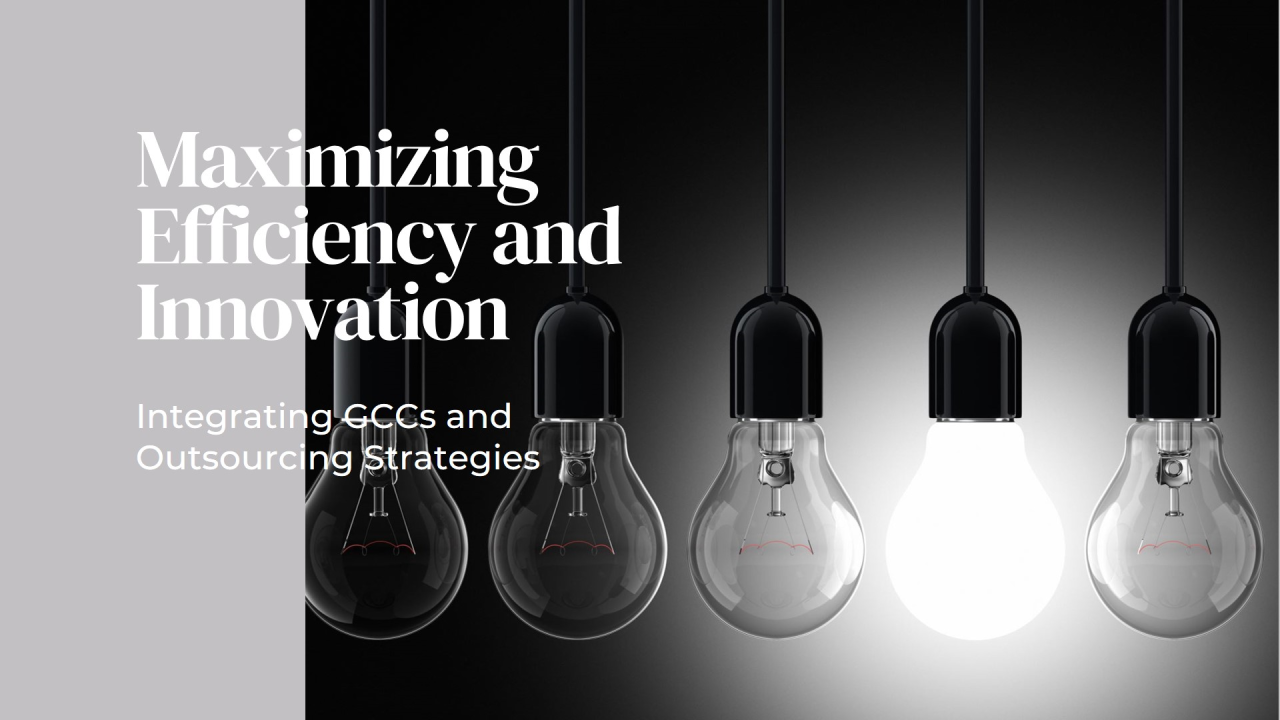Maximizing Efficiency and Innovation: How to Integrate GCCs and Outsourcing Strategies

July 4th,
2024
In the dynamic landscape of global business operations, companies are constantly exploring ways to maximize efficiency and drive innovation. While outsourcing and Global Capability Centres (GCCs) each offer unique advantages, integrating these strategies can unlock even greater potential. This article explores how businesses can effectively combine GCCs and outsourcing to achieve their strategic objectives.
Introduction
Previously, we discussed the distinct advantages and considerations of Outsourcing vs. GCCs. Outsourcing provides cost efficiencies and access to specialized expertise, while GCCs offer control, strategic alignment, and innovation capabilities. Integrating both strategies can help businesses harness the best of both worlds, enhancing their competitive edge.
Understanding the Complementary Roles of GCCs and Outsourcing
GCCs and outsourcing serve different but complementary purposes. While GCCs function as extensions of the parent company, focusing on core business processes and innovation, outsourcing partners handle non-core functions, allowing companies to focus on their strategic priorities.
Case Study: Microsoft
Microsoft leverages both GCCs and outsourcing to drive efficiency and innovation. Their GCC in India focuses on core software development and innovation, while outsourcing partners handle customer support and IT infrastructure management. This strategic division of labor allows Microsoft to innovate rapidly while maintaining operational efficiency.
Strategic Planning for Integration
To integrate GCCs and outsourcing effectively, companies must start with a clear strategic plan:
Assess Company Needs:
Identify which functions are best suited for GCCs and which can be outsourced.
Define Objectives:
Set clear goals for both GCCs and outsourcing partnerships to ensure alignment with overall business strategy.
Operational Models
Several models can be used to integrate GCCs and outsourcing:
Hybrid Model:
Combines in-house GCCs for strategic functions with outsourced partners for non-core activities.
Collaborative Model:
Involves close collaboration between GCCs and outsourcing partners, sharing resources and expertise.
Pros and Cons:
Hybrid Model:
Offers flexibility and cost efficiency but may require complex management.
Collaborative Model:
Promotes innovation and synergy but demands strong governance and communication.
Technology and Innovation
Leveraging technology is crucial for the successful integration of GCCs and outsourcing. Technologies such as AI, machine learning, and cloud computing can enhance collaboration and efficiency.
Example: Tech Mahindra
Tech Mahindra uses AI-driven platforms to integrate its GCCs and outsourcing operations. This integration has led to improved process automation, reduced turnaround times, and enhanced innovation in service delivery.
Talent Management
Developing a cohesive talent strategy across GCCs and outsourced teams is vital. This includes upskilling and reskilling programs to ensure all teams are equipped with the necessary skills.
Example: JPMorgan Chase
JPMorgan Chase implements continuous learning programs across its GCCs and outsourcing partners. By investing in employee development, they ensure that their workforce remains skilled and adaptable to changing market demands.
Governance and Compliance
Establishing robust governance frameworks is essential to manage integrated operations effectively. This includes ensuring compliance with local and international regulations.
Example: HSBC
HSBC has a comprehensive governance framework that oversees its GCCs and outsourcing partners. This framework ensures that all operations adhere to regulatory requirements and internal standards, mitigating risks and ensuring operational integrity.
Performance Metrics and KPIs
Measuring the success of integrated strategies requires clear performance metrics and KPIs. These should focus on efficiency, innovation, and customer satisfaction.
Example: Pfizer
Pfizer uses a balanced scorecard approach to measure the performance of its GCCs and outsourcing partners. Key metrics include cost savings, process efficiency, and innovation outcomes. This holistic view enables Pfizer to continuously improve its operations.
Challenges and Solutions
Integrating GCCs and outsourcing can present several challenges, including cultural differences, communication barriers, and management complexities. However, these challenges can be addressed through:
Clear Communication Channels:
Establishing effective communication channels to ensure seamless collaboration.
Cultural Sensitivity Training:
Providing training to bridge cultural differences and enhance teamwork.
Strong Leadership:
Ensuring strong leadership to manage and integrate diverse teams effectively.
Future Trends
Emerging trends in the integration of GCCs and outsourcing include increased use of AI and automation, greater focus on cybersecurity, and the rise of remote working models. Companies that embrace these trends will be better positioned to innovate and remain competitive.
Conclusion
Integrating GCCs and outsourcing strategies offers significant benefits, including enhanced efficiency, innovation, and cost savings. By adopting a holistic approach and focusing on continuous learning and development, companies can unlock the full potential of these complementary strategies and drive sustainable growth.



